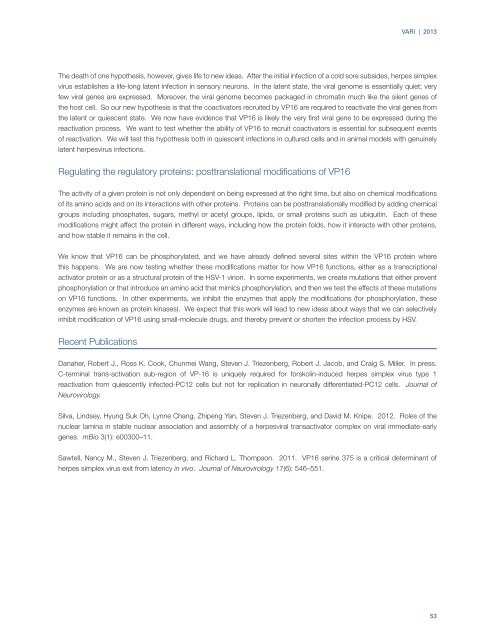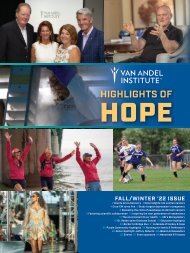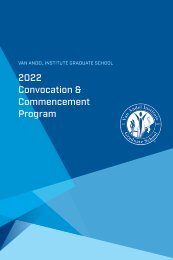2013 Scientific Report
Create successful ePaper yourself
Turn your PDF publications into a flip-book with our unique Google optimized e-Paper software.
VARI | <strong>2013</strong><br />
The death of one hypothesis, however, gives life to new ideas. After the initial infection of a cold sore subsides, herpes simplex<br />
virus establishes a life-long latent infection in sensory neurons. In the latent state, the viral genome is essentially quiet; very<br />
few viral genes are expressed. Moreover, the viral genome becomes packaged in chromatin much like the silent genes of<br />
the host cell. So our new hypothesis is that the coactivators recruited by VP16 are required to reactivate the viral genes from<br />
the latent or quiescent state. We now have evidence that VP16 is likely the very first viral gene to be expressed during the<br />
reactivation process. We want to test whether the ability of VP16 to recruit coactivators is essential for subsequent events<br />
of reactivation. We will test this hypothesis both in quiescent infections in cultured cells and in animal models with genuinely<br />
latent herpesvirus infections.<br />
Regulating the regulatory proteins: posttranslational modifications of VP16<br />
The activity of a given protein is not only dependent on being expressed at the right time, but also on chemical modifications<br />
of its amino acids and on its interactions with other proteins. Proteins can be posttranslationally modified by adding chemical<br />
groups including phosphates, sugars, methyl or acetyl groups, lipids, or small proteins such as ubiquitin. Each of these<br />
modifications might affect the protein in different ways, including how the protein folds, how it interacts with other proteins,<br />
and how stable it remains in the cell.<br />
We know that VP16 can be phosphorylated, and we have already defined several sites within the VP16 protein where<br />
this happens. We are now testing whether these modifications matter for how VP16 functions, either as a transcriptional<br />
activator protein or as a structural protein of the HSV-1 virion. In some experiments, we create mutations that either prevent<br />
phosphorylation or that introduce an amino acid that mimics phosphorylation, and then we test the effects of these mutations<br />
on VP16 functions. In other experiments, we inhibit the enzymes that apply the modifications (for phosphorylation, these<br />
enzymes are known as protein kinases). We expect that this work will lead to new ideas about ways that we can selectively<br />
inhibit modification of VP16 using small-molecule drugs, and thereby prevent or shorten the infection process by HSV.<br />
Recent Publications<br />
Danaher, Robert J., Ross K. Cook, Chunmei Wang, Steven J. Triezenberg, Robert J. Jacob, and Craig S. Miller. In press.<br />
C-terminal trans-activation sub-region of VP-16 is uniquely required for forskolin-induced herpes simplex virus type 1<br />
reactivation from quiescently infected-PC12 cells but not for replication in neuronally differentiated-PC12 cells. Journal of<br />
Neurovirology.<br />
Silva, Lindsey, Hyung Suk Oh, Lynne Chang, Zhipeng Yan, Steven J. Triezenberg, and David M. Knipe. 2012. Roles of the<br />
nuclear lamina in stable nuclear association and assembly of a herpesviral transactivator complex on viral immediate-early<br />
genes. mBio 3(1): e00300–11.<br />
Sawtell, Nancy M., Steven J. Triezenberg, and Richard L. Thompson. 2011. VP16 serine 375 is a critical determinant of<br />
herpes simplex virus exit from latency in vivo. Journal of Neurovirology 17(6): 546–551.<br />
53
















